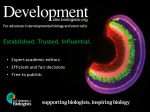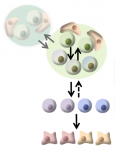In Development this week (Vol. 142, Issue 8)
Posted by Seema Grewal, on 7 April 2015
Here are the highlights from the current issue of Development:
Getting to the heart of human epicardial differentiation
 The epicardium is crucial for heart development and function, and it has also emerged as a potential source of multipotent progenitors that can contribute to heart repair. But how epicardial cells develop in humans and how they might contribute to heart regeneration is unclear, partly because methods to study them have been lacking. Here (p. 1528), Sanjay Sinha and colleagues describe a robust protocol for generating epicardial cells and their differentiated progeny from human pluripotent stem cells (HPSCs) under defined chemical conditions. They first use FGF2 and BMP4 to differentiate HPSCs to a lateral plate mesoderm intermediate. A combination of WNT, retinoic acid and BMP signals, they report, then drives differentiation to an epicardial fate. The resulting cells express epicardial-specific markers and exhibit a morphology that is characteristic of human foetal epicardial cells. The authors further demonstrate that HPSC-derived epicardial cells can undergo EMT and differentiate into smooth muscle cells and cardiac fibroblasts. Importantly, they show that, when injected into developing chick embryos, HPSC-derived epicardial cells localise to the subepicardial space and integrate into coronary vessels. This method thus provides both a novel system for understanding epicardial development in humans and a potential platform for drug screening and modelling vascular disease.
The epicardium is crucial for heart development and function, and it has also emerged as a potential source of multipotent progenitors that can contribute to heart repair. But how epicardial cells develop in humans and how they might contribute to heart regeneration is unclear, partly because methods to study them have been lacking. Here (p. 1528), Sanjay Sinha and colleagues describe a robust protocol for generating epicardial cells and their differentiated progeny from human pluripotent stem cells (HPSCs) under defined chemical conditions. They first use FGF2 and BMP4 to differentiate HPSCs to a lateral plate mesoderm intermediate. A combination of WNT, retinoic acid and BMP signals, they report, then drives differentiation to an epicardial fate. The resulting cells express epicardial-specific markers and exhibit a morphology that is characteristic of human foetal epicardial cells. The authors further demonstrate that HPSC-derived epicardial cells can undergo EMT and differentiate into smooth muscle cells and cardiac fibroblasts. Importantly, they show that, when injected into developing chick embryos, HPSC-derived epicardial cells localise to the subepicardial space and integrate into coronary vessels. This method thus provides both a novel system for understanding epicardial development in humans and a potential platform for drug screening and modelling vascular disease.
From A to B: glucagon governs pancreatic fate switches
 Diabetes is caused by the loss or dysfunction of pancreatic β cells, and approaches to restore β cell numbers therefore offer attractive therapeutic avenues. Recent studies have revealed that other pancreatic endocrine cells, such as glucagon-producing α cells, can transdifferentiate into β cells following β cell depletion but what controls this cell fate switch is unclear. Now, Ryan Anderson and co-workers demonstrate that activation of the glucagon gene is essential for α cell transdifferentiation in zebrafish embryos (p. 1407). Using lineage tracing, they demonstrate that islet regeneration following β cell ablation occurs via β cell neogenesis, with new cells arising from pre-existing α cells and naïve progenitors. The depletion of α cells confirms their role in β cell neogenesis and suggests that they might provide cues that regulate β cell neogenesis. Following this, the authors reveal that glucagonis upregulated following injury and that glucagon gene products are required for islet regeneration. Finally, they show that, although glucagon is known to increase hepatic glucose levels, glucose alone cannot stimulate α cell transdifferentiation, suggesting that glucagon acts directly on α cells. Together, these findings reveal that glucagon plays a crucial role in maintaining pancreatic cell homeostasis, a role that could be exploited pharmacologically.
Diabetes is caused by the loss or dysfunction of pancreatic β cells, and approaches to restore β cell numbers therefore offer attractive therapeutic avenues. Recent studies have revealed that other pancreatic endocrine cells, such as glucagon-producing α cells, can transdifferentiate into β cells following β cell depletion but what controls this cell fate switch is unclear. Now, Ryan Anderson and co-workers demonstrate that activation of the glucagon gene is essential for α cell transdifferentiation in zebrafish embryos (p. 1407). Using lineage tracing, they demonstrate that islet regeneration following β cell ablation occurs via β cell neogenesis, with new cells arising from pre-existing α cells and naïve progenitors. The depletion of α cells confirms their role in β cell neogenesis and suggests that they might provide cues that regulate β cell neogenesis. Following this, the authors reveal that glucagonis upregulated following injury and that glucagon gene products are required for islet regeneration. Finally, they show that, although glucagon is known to increase hepatic glucose levels, glucose alone cannot stimulate α cell transdifferentiation, suggesting that glucagon acts directly on α cells. Together, these findings reveal that glucagon plays a crucial role in maintaining pancreatic cell homeostasis, a role that could be exploited pharmacologically.
Rooting for a role for PIP2 in plants
 Genes involved in phosphoinositide signalling are conserved across eukaryotes, yet their role in plant development remains unclear. Now (p. 1437), Christian Hardtke and colleagues reveal that balanced phosphatidylinositol-4,5-bisphosphate (PIP2) levels are required for differentiation of the Arabidopsisprotophloem, a specialised vascular tissue found in the root. The researchers analyse plants harbouring mutations in COTYLEDON VASCULAR PATTERN 2(CVP2) and its partially redundant homolog CVP2-LIKE 1 (CVL1), which encode phosphoinositide 5-phosphatases that convert PIP2 into phosphatidylinositolphosphate (PIP). They reveal that a second site mutation in cvp2partially rescues previously identified mutants with impaired protophloem development, suggesting that PIP2 levels modulate protophloem differentiation. In line with this, they demonstrate that CVP2 hyperactivation impairs protophloem differentiation and overall root growth. The researchers further show that, while cvp2 and cvl1 single mutants display no apparent root defects, double mutants paradoxically also exhibit protophloem differentiation defects and a skewed PIP to PIP2 ratio. Finally, they report, this impaired protophloem differentiation systemically alters the auxin response in the root system and, hence, lateral root emergence. In summary, these findings highlight a crucial role for tightly regulated PIP2levels in the Arabidopsis root and suggest that activity in the primary root protophloem shapes root architecture.
Genes involved in phosphoinositide signalling are conserved across eukaryotes, yet their role in plant development remains unclear. Now (p. 1437), Christian Hardtke and colleagues reveal that balanced phosphatidylinositol-4,5-bisphosphate (PIP2) levels are required for differentiation of the Arabidopsisprotophloem, a specialised vascular tissue found in the root. The researchers analyse plants harbouring mutations in COTYLEDON VASCULAR PATTERN 2(CVP2) and its partially redundant homolog CVP2-LIKE 1 (CVL1), which encode phosphoinositide 5-phosphatases that convert PIP2 into phosphatidylinositolphosphate (PIP). They reveal that a second site mutation in cvp2partially rescues previously identified mutants with impaired protophloem development, suggesting that PIP2 levels modulate protophloem differentiation. In line with this, they demonstrate that CVP2 hyperactivation impairs protophloem differentiation and overall root growth. The researchers further show that, while cvp2 and cvl1 single mutants display no apparent root defects, double mutants paradoxically also exhibit protophloem differentiation defects and a skewed PIP to PIP2 ratio. Finally, they report, this impaired protophloem differentiation systemically alters the auxin response in the root system and, hence, lateral root emergence. In summary, these findings highlight a crucial role for tightly regulated PIP2levels in the Arabidopsis root and suggest that activity in the primary root protophloem shapes root architecture.
Slitting open muscle morphogenesis
 Muscle migration and attachment to tendons are crucial steps in establishing a contractile muscle that is able to move bones. However, how this encounter between muscle and tendon cells is coordinated remains unclear. In the early stages of development, Slit, a large cleavable protein secreted by midline glia, repels migrating muscle cells. Later, it reportedly acts as a muscle attractant. How does Slit achieve this dual role and does its cleavage contribute to its function? Using live imaging of different slit mutant Drosophila embryos (devoid of Slit or expressing an uncleavable form of the protein), Talila Volk and co-workers reveal that Slit actually acts exclusively as a repellent and stop signal for muscle cells (p. 1431). Furthermore, the authors show that the processing of Slit into a more stable N-terminal form tethered to the tendon cell membrane restricts its action and is crucial for the short-range repulsion and arrest of muscle cell migration. This study thus uncovers a novel regulatory mechanism controlling Slit function and distribution during muscle morphogenesis that is likely to operate in other tissues such as the heart and blood vessels.
Muscle migration and attachment to tendons are crucial steps in establishing a contractile muscle that is able to move bones. However, how this encounter between muscle and tendon cells is coordinated remains unclear. In the early stages of development, Slit, a large cleavable protein secreted by midline glia, repels migrating muscle cells. Later, it reportedly acts as a muscle attractant. How does Slit achieve this dual role and does its cleavage contribute to its function? Using live imaging of different slit mutant Drosophila embryos (devoid of Slit or expressing an uncleavable form of the protein), Talila Volk and co-workers reveal that Slit actually acts exclusively as a repellent and stop signal for muscle cells (p. 1431). Furthermore, the authors show that the processing of Slit into a more stable N-terminal form tethered to the tendon cell membrane restricts its action and is crucial for the short-range repulsion and arrest of muscle cell migration. This study thus uncovers a novel regulatory mechanism controlling Slit function and distribution during muscle morphogenesis that is likely to operate in other tissues such as the heart and blood vessels.
PLUS…
Developing peer review
 Several changes to Development‘s Reviewer Guidelines and Report Forms have just been introduced. These changes, which aim to make the peer-review process more efficient and helpful for authors, are explained in the Editorial on p. 1389
Several changes to Development‘s Reviewer Guidelines and Report Forms have just been introduced. These changes, which aim to make the peer-review process more efficient and helpful for authors, are explained in the Editorial on p. 1389
Lysophosphatidic acid signalling in development
 Lysophosphatidic acid (LPA) is a bioactive phospholipid that regulates cell survival, proliferation, differentiation, migration, adhesion and morphology. These LPA-influenced processes impact many aspects of organismal development. In their short poster article, Jerold Chun and colleagues review the developmentally related features of LPA signalling. See the Development at a Glance article on p. 1390
Lysophosphatidic acid (LPA) is a bioactive phospholipid that regulates cell survival, proliferation, differentiation, migration, adhesion and morphology. These LPA-influenced processes impact many aspects of organismal development. In their short poster article, Jerold Chun and colleagues review the developmentally related features of LPA signalling. See the Development at a Glance article on p. 1390
Dynamic stem cell heterogeneity
 Recent lineage-tracing studies based on inducible genetic labelling have emphasized a crucial role for stochasticity in the maintenance and regeneration of cycling adult tissues. These studies have revealed that stem cells are frequently lost through differentiation and that this is compensated for by the duplication of neighbours, leading to the consolidation of clonal diversity. With a focus on mammalian spermatogenesis, intestinal maintenance and the hair cycle, Teresa Krieger and Ben Simons review the role of dynamic heterogeneity in the regulation of adult stem cell populations. See the Review article on p. 1396
Recent lineage-tracing studies based on inducible genetic labelling have emphasized a crucial role for stochasticity in the maintenance and regeneration of cycling adult tissues. These studies have revealed that stem cells are frequently lost through differentiation and that this is compensated for by the duplication of neighbours, leading to the consolidation of clonal diversity. With a focus on mammalian spermatogenesis, intestinal maintenance and the hair cycle, Teresa Krieger and Ben Simons review the role of dynamic heterogeneity in the regulation of adult stem cell populations. See the Review article on p. 1396


 (No Ratings Yet)
(No Ratings Yet)